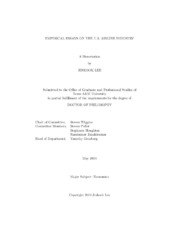| dc.description.abstract | This dissertation studies the effects of firm's collaborative strategy on both demand
and supply, and equilibrium to derive various welfare implications. I explain both
horizontal mergers and vertical relationships, focusing on the U.S. airline industry.
In the first study, I address significant limitations of traditional merger simulations which have focused solely on price changes while constraining the set of product characteristics to be identical pre- and post-merger. To overcome the limitations, I endogenize both prices and product characteristics by specifying a two-stage oligopoly game. After estimating demand and supply system, I simulate the effect of the Delta and Northwest Airlines merger on prices, product characteristics, and welfare. The simulation results show that the merged rm tends to increase product differentiation post-merger, the higher product differentiation reduces the firm's incentive to raise prices, and the changes in characteristics and prices increase not only the merged firm's profit but also consumer welfare. I also compare the predicted to actual post-merger outcome and find that endogenizing product characteristics is essential to better predict the actual outcome.
The second study investigates the impact of contractual agreements regarding
gates between airports and carriers on major carrier's market power. Competition
Plans reported by thirty one hub airports provide information on a carrier's gate-
occupancy, sublease agreement, and Majority-In-Interest clauses at an airport. I
estimate the effects of these contractual practices on passengers' utility and carriers'
marginal costs. The main results show that a carrier's gate dominance has a positive
effect on the demand side through passengers' utility, and business travelers have a
higher willingness to pay for gates than tourists. On the supply side, a carrier's gate
dominance decreases its own marginal cost, especially when the airport is congested.
Furthermore, the existence of sublease agreement at an airport is likely to increase
non-signatory carriers' marginal costs, whereas the provision of Majority-In-Interest
clauses increases signatory carriers' marginal costs. Based on the estimates, I execute
a counterfactual analysis and nd that regulatory limits on gate occupancy can
reduce the di erentials in costs and pro ts between signatory and non-signatory
airlines. | en |


